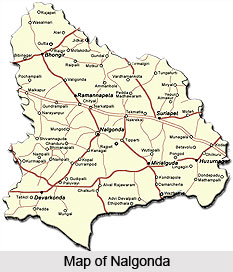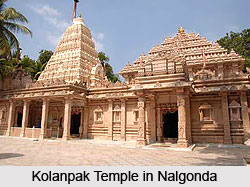 Nalgonda is a town and a municipality located in Nalgonda district in the Indian state of Telangana, with Hyderabad as its capital for the span of 10 years. The name Nalgonda is derived from two Telugu words "Nalla" (Black) and "Konda" (hill). Nalgonda, an urbanised city is located at 17.050 degree North to 79.2667 degree East. It has an average elevation of 420 metres.
Nalgonda is a town and a municipality located in Nalgonda district in the Indian state of Telangana, with Hyderabad as its capital for the span of 10 years. The name Nalgonda is derived from two Telugu words "Nalla" (Black) and "Konda" (hill). Nalgonda, an urbanised city is located at 17.050 degree North to 79.2667 degree East. It has an average elevation of 420 metres.
History of Nalgonda
In the ancient times, Nalgonda was referred to as "Nilagiri". During the period of Bahamani kingdom, it had been renamed as Nallagonda. Later during the rule of Nizam Dynasty in the later medieval period, during the later kings rule the name has been transformed into Nalgonda. This is also the district headquarters. Nalgonda or Nilagiri is a place of early settlement from ancient times. In old city centre, there is an Ashoka Pillar. The Panagal village was actually the city centre during the rule of Kakatiya Dynasty. It is place where one can find the exquisite and highly artful temple of emerald is the Someswara Temple, Chaya Someswara Temple and Venkateswara Temple are found. The sculpture of emerald Someswara Temple is par excellence and highly skilfully carved pillars demonstrate the artisans" mastery as well as devotion.
 Demography of Nalgonda
Demography of Nalgonda
According to the Population Census in the year 2011, Nalgonda had a population of 135,163. The males constitute 51 percent of the population and females 49 percent. Nalgonda has an average literacy rate of 87.08 percent, higher than the national average of 59.50 percent. The male literacy rate is 92.23 percent, and female literacy rate is 81.92 percent. In Nalgonda, 11 percent of the population is under 6 years of age.
Tourism of Nalgonda
It is said that the temple is called Emerald Someswara Temple. It was endowed with an emerald which filled the entire temple with light reflected from it in day and night. The structure follows "trikuta" architecture style with Main sanctum of Shiva, and sanctum of Parvati, the consort of Lord Shiva placed opposite, and Sanctorum of Skanda placed on the right of main sanctum.
Emerald Someswara Temple went under the ruins for many years. The Archaeological Survey of India, however, later on tried to protect the Temple by a fence, and the Temple stands in its glory with its pillars in-tact.
Similarly, the Chaya Someswara Temple bears the works of architectural wonder, where any time in day or night a column of shadow is seen exactly on the deity Lord Shiva or Mahadeva without any change throughout the year. Also, the deity of Chaya Someswara Temple always rests in water skilfully drawn from a nearby lake called Panagal Cheruvu. The whole construction and water circulating arrangement is as thought the deity is endowed with cool environs. Panagal Cheruvu is also said to be very old with a "Silasashana" giving its origin. Main interesting feature of the stone carvings is that the script on it is Brahmi script indicating its very ancient origin.
Nilagiri or Nalagonda is also endowed with two hills. Where on one hill there is a fort, and another hill of huge rock of granite where a temple is seen. Nalagonda hill on its one side has a huge rock of smooth surface embellished with rectangular indentures for help walking on it to reach the temple.
The another interesting feature of this hill is that, there is large reservoir of water inside a hollow of the rock on another side with small opening to be seen as if water is stored by some-one in a pot of giant size. At all times of the year it is filled to the brim.
Nalagonda hill is present with a fort called "Kapurala" Gutta indicating that the families of the rulers were kept safe as this hill is very steep on all sides. This fort also has a very deep well to supply water for the settlements for a long time.



















